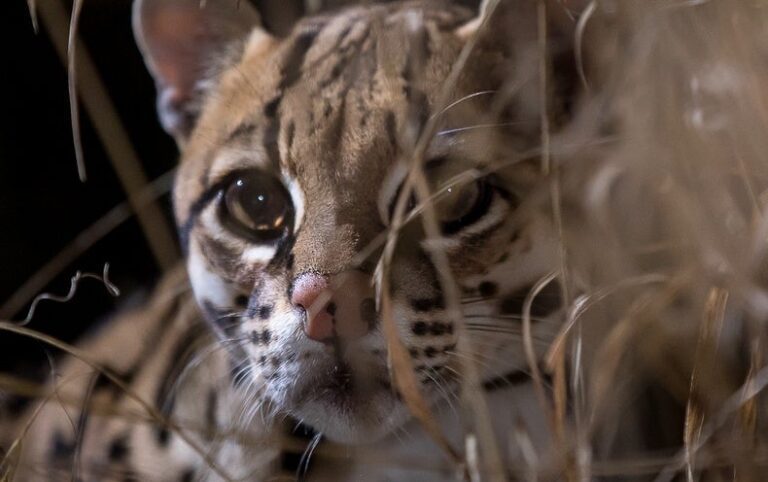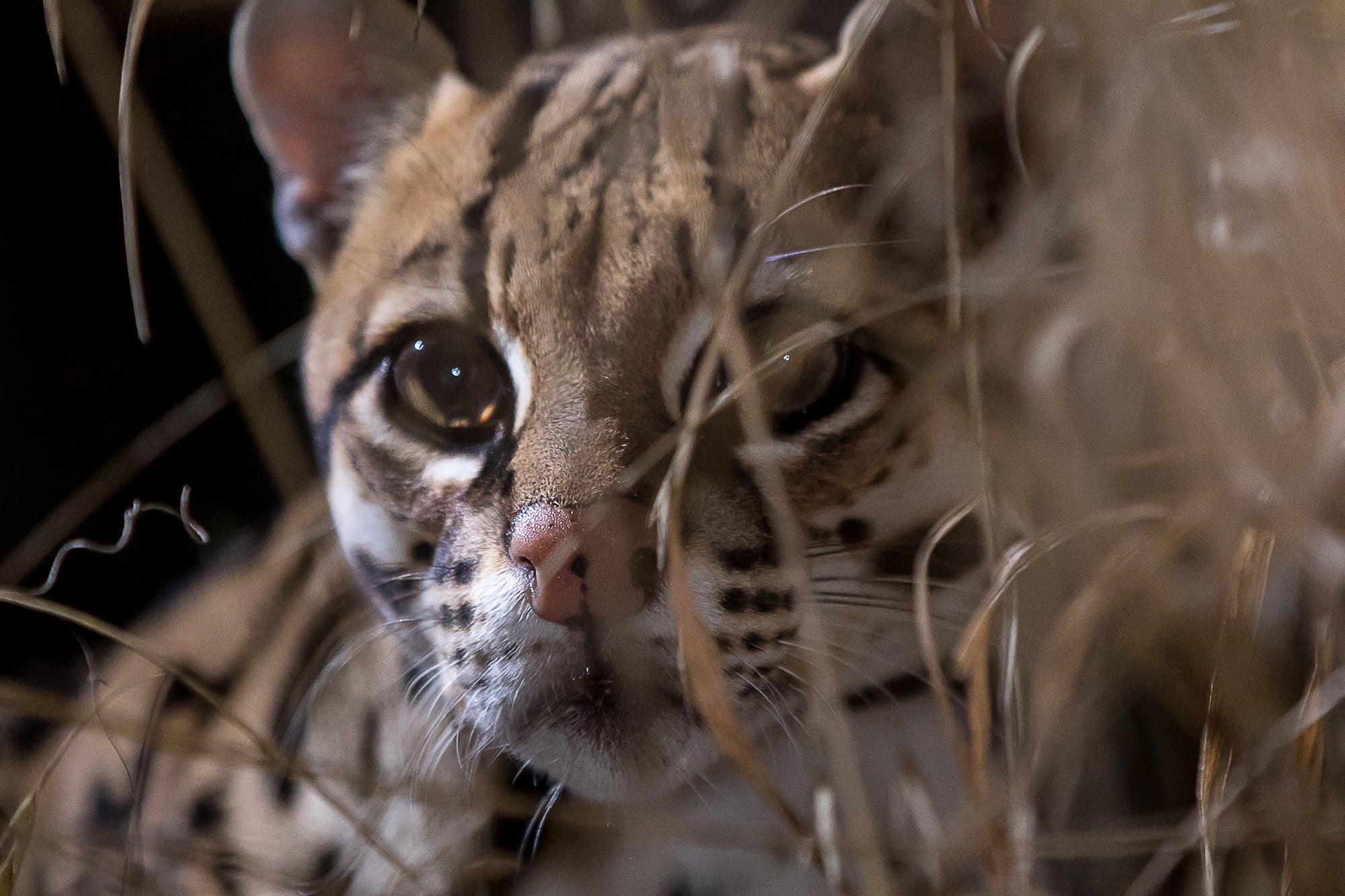
[ad_1]

Research veterinarian Ashley Reeves had a rough week in mid-August. She had hoped to artificially inseminate ocelots at three zoos as part of a project to save these small, elegant spotted cats in the wild. But one female failed to ovulate, another had complications with her egg, and sperm for the third had lost much of its motility—its ability to travel into the oviduct and fertilize an egg—during shipment to the zoo, all of which made pregnancy less likely. Although Reeves finished the procedures, she won’t know for if they worked until another month passes. “What we are trying to do is very complicated,” she says.
These attempts are part of an ambitious plan to artificially inseminate female ocelots born and raised in zoos using sperm extracted from wild ocelots in southern Texas—a first step in establishing a new population of this endangered cat. If successful, the work will be the first to artificially inseminate zoo ocelots with wild sperm and then repopulate the species in the wild.
Wild ocelots are now found mainly in parts of Mexico and other countries in Latin America. They once roamed throughout Texas and neighboring states. Today, however, only two small, isolated populations remain in the U.S. The largest of these, with roughly 60 animals, exists on private ranchlands in southeastern Texas. A smaller population hugs the Gulf of Mexico in the Laguna Atascosa National Wildlife Refuge—these cats are a mere 20 miles away from the larger group but are separated from their brethren by deadly roadways and fragmented habitat.
Texas ocelots favor a particularly prickly type of habitat called thorn scrub: dense brush composed of spiky plants. Useless to people, most thorn scrub has been removed as agriculture, urbanization and the border wall consume much of southern Texas’s landscape. Yet the nonprofit East Foundation, founded in 2007 to demonstrate that ranching and wildlife can coexist, owns 217,000 acres of ranchland in prime ocelot territory—and a significant amount of it is still a thorn scrub region. Part of the larger existing U.S. ocelot population roams one of the foundation’s properties north of the wildlife refuge. Biologists have identified a separate piece of the organization’s land that they believe can support a third population of ocelots that is farther inland than the existing groups. This would reduce the risk of hurricanes wiping out the few remaining cats, and the new population would also be surrounded by fewer menacing highways.
But first, the land needs more ocelots. And it needs more genetic diversity to counter the inbreeding found in the few wild ocelots that remain. That’s where zoos come in.
Zoos across the U.S. have been breeding endangered species, including ocelots, for decades. They have used a variety of techniques, including carefully pairing animals to reproduce naturally and applying assisted reproduction technologies, such as artificial insemination and in vitro fertilization, to maximize captive populations’ genetic diversity. As a result, zoo ocelots today are a genetic mix that reflects the diversity found throughout their ancestral range in Latin America. Impregnating captive ocelots with wild sperm has never occurred, however.
Conservation biologists generally like to retain the unique genetic makeup of each lineage of a species in the wild, which can vary throughout its range. But scientists such as William Swanson—who directs animal conservation research at the Cincinnati Zoo & Botanical Garden and assisted Reeves with the artificial insemination procedures—believe Texas ocelots will benefit from new genes that zoo ocelots can provide. “Limited gene diversity and small populations are a recipe for extinction,” he says.
Stuart Pimm, a professor of conservation ecology at Duke University, agrees. Pimm isn’t involved in the ocelot effort but analyzed the benefits of introducing eight female Texas cougars into panther habitat in Florida in 1995. (The Florida panther is a subspecies of cougar.) He notes that many scientists opposed introducing non-Florida genes into the population at the time despite the fact that intensive inbreeding had weakened the endangered panthers. A subsequent analysis revealed that the cougar genes increased panther numbers for generations.
“Do I care that the cats they bring in aren’t Texas ocelots?” Pimm asks. “Hell no. I think the fact that they might be a genetic mishmash might be a good thing. I think it’s much more important that the Texas bush country has ocelots than that it has ocelots of Texas heritage.”
Artificial insemination is tricky, however, and Paul Marinari, senior curator at the Smithsonian Conservation Biology Institute, thinks relying solely on this technique is a risk. Marinari’s team has depended heavily on natural breeding to build up the captive population of endangered black-footed ferrets—a member of the weasel family that was reduced to 18 individuals in the 1980s—and reintroduce them to the plains of North America. His team knows the genetic makeup of each animal in its facilities, and it pairs males and females carefully to enhance genetic diversity by allowing ferrets to breed naturally. The institute uses artificial insemination primarily to breed genetically unique animals that haven’t managed to mate successfully with their partners.
“When trying to save endangered species, you need every possible tool out there: cloning, artificial insemination, in vitro and natural breeding,” Marinari says. Thousands of captive-born black-footed ferrets have been released into the wild. Some of those animals might have resulted from artificial insemination, and others have been the offspring of ferrets produced through artificial insemination, he says. But Marinari usually keeps animals generated by artificial insemination captive for future breeding; this helps ensure that valuable genes will become established more broadly into the population first rather than die an early death on North America’s prairies. And no one has created an entire population of black-footed ferrets using any assisted reproduction techniques.
The ocelot endeavor is a novel approach, Marinari says. “The success rate of assisted reproduction is lower than natural breeding, which is why most programs use natural breeding and supplement with assisted reproduction,” he adds.
Reeves and Swanson artificially inseminated nine zoo ocelots with sperm from the wild Texas animals in 2021 and 2022, and no pregnancies resulted. They plan on three more efforts later this year. But freezing sperm, a necessity when recovering semen from wild males in the field, reduces its motility. Inbreeding in the isolated wild ocelots further diminishes this. Yet in the past Swanson successfully inseminated three zoo ocelots using frozen nonwild sperm, resulting in kittens.
“I know if we do enough artificial insemination, we can make this work,” Swanson maintains. “The hard part is making these ocelots wild again. They’ve never been in a wild situation, and their mothers have never been wild…. No one has done this rewilding of a population of any cat from a zoo-based population.”
Pimm agrees and fears the ocelot effort will fail because of this challenge. “That’s the weak link in this,” he says. “Putting captive-bred animals into the wild is very, very difficult…. There’s a reason why animals need their mums—especially with cats. Mum looks after the babies and shows them how it’s done.”
The Smithsonian Conservation Biology Institute and its partners in ferret rewilding keep animals slated for release in natural enclosures, ensure they have live prey to hunt and then place them in preconditioning pens with colonies of prairie dogs (their primary prey) for 30 days. “Anyone who survives that—not sleeping on the ground or cohabitating with prairie dogs—goes on to reintroduction,” Marinari says. Studies show that preconditioning helps the ferrets’ survival rate.
It’s not clear if similar techniques will work for ocelots. The closest example of rewilding captive-born cats is the Iberian lynx. From two small remnant populations, biologists started a captive-breeding program with wild “founder” animals captured in the early 2000s and reintroduced their descendants throughout Portugal and Spain. The East Foundation is drawing on this experience, and it now has plans and funding to build “wilding” enclosures with its partners at Texas A&M University to keep its cats in natural surroundings, where they can learn to hunt live prey and to fear humans.
If Reeves’s inseminations this August worked, she should know within the next 50 days—with kittens emerging a week or two later. Then, in two to three years, these kittens will be bred with wild Texas ocelots to reinforce their Texas lineage—and will subsequently become the parents of ocelots that will eventually be released into the wild.
And if artificial insemination or rewilding doesn’t work? “We will have to take another avenue,” Reeves says. “We won’t quit. We’ll just have to do something different.”
[ad_2]